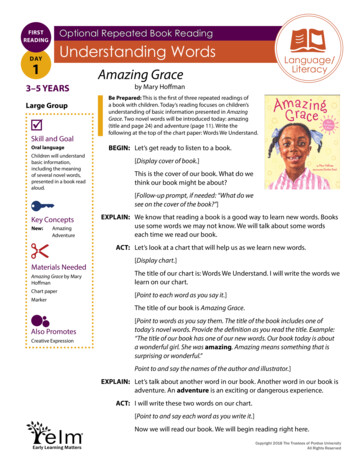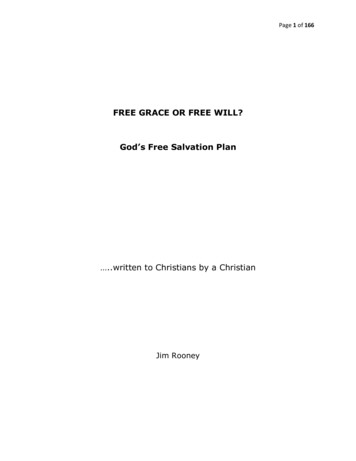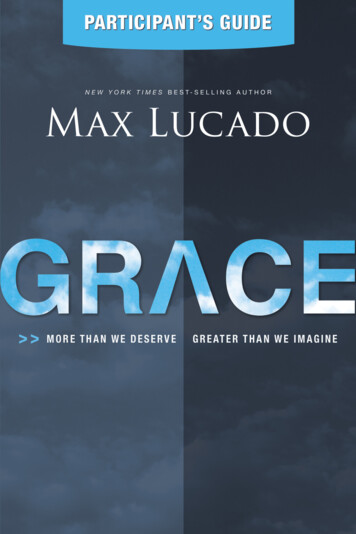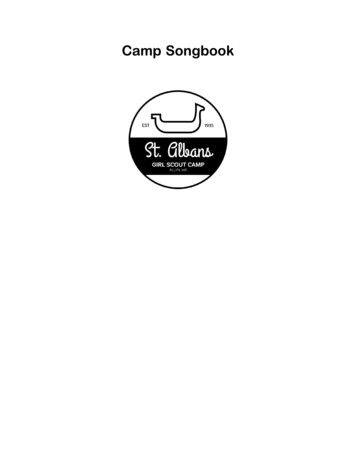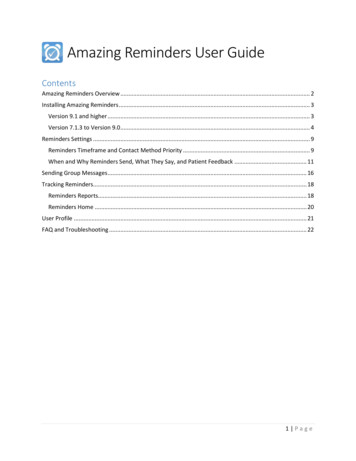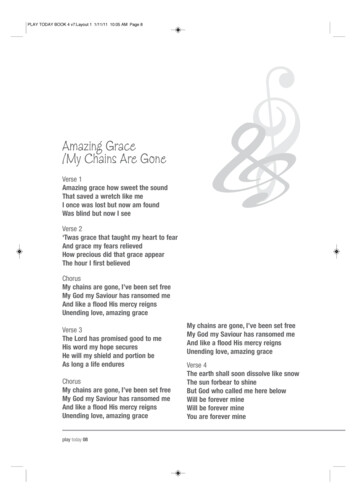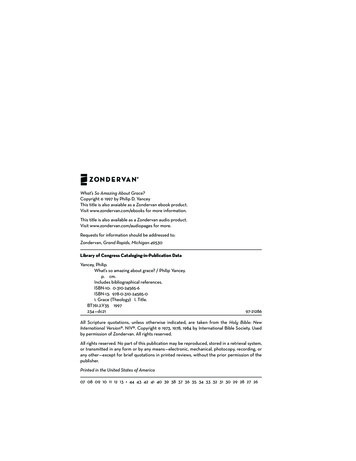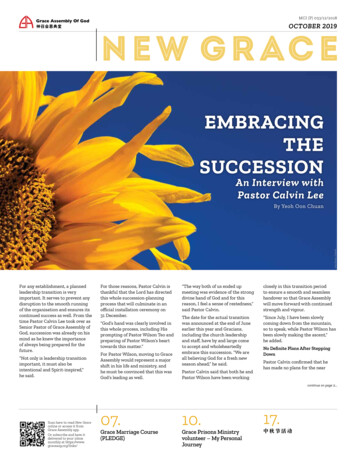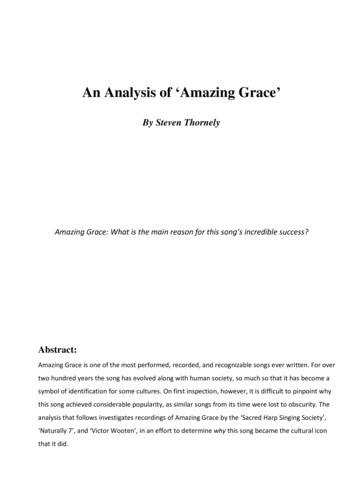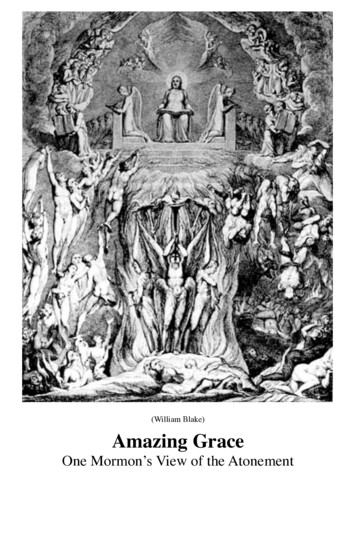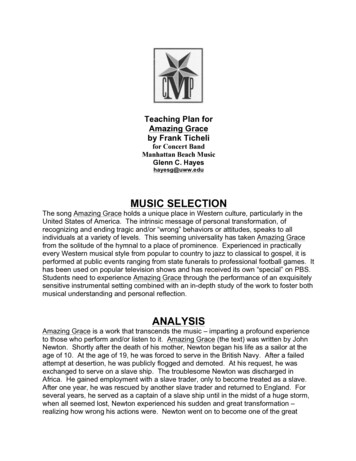
Transcription
Teaching Plan forAmazing Graceby Frank Tichelifor Concert BandManhattan Beach MusicGlenn C. Hayeshayesg@uww.eduMUSIC SELECTIONThe song Amazing Grace holds a unique place in Western culture, particularly in theUnited States of America. The intrinsic message of personal transformation, ofrecognizing and ending tragic and/or “wrong” behaviors or attitudes, speaks to allindividuals at a variety of levels. This seeming universality has taken Amazing Gracefrom the solitude of the hymnal to a place of prominence. Experienced in practicallyevery Western musical style from popular to country to jazz to classical to gospel, it isperformed at public events ranging from state funerals to professional football games. Ithas been used on popular television shows and has received its own “special” on PBS.Students need to experience Amazing Grace through the performance of an exquisitelysensitive instrumental setting combined with an in-depth study of the work to foster bothmusical understanding and personal reflection.ANALYSISAmazing Grace is a work that transcends the music – imparting a profound experienceto those who perform and/or listen to it. Amazing Grace (the text) was written by JohnNewton. Shortly after the death of his mother, Newton began his life as a sailor at theage of 10. At the age of 19, he was forced to serve in the British Navy. After a failedattempt at desertion, he was publicly flogged and demoted. At his request, he wasexchanged to serve on a slave ship. The troublesome Newton was discharged inAfrica. He gained employment with a slave trader, only to become treated as a slave.After one year, he was rescued by another slave trader and returned to England. Forseveral years, he served as a captain of a slave ship until in the midst of a huge storm,when all seemed lost, Newton experienced his sudden and great transformation –realizing how wrong his actions were. Newton went on to become one of the great
church leaders of England. His writings and speeches are directly credited for theinspiration for the abolishment of slavery in England and fueling the fires of the FreeSlave movement in the United States.The form of this version might best be described as a quasi-sonata allegro form. All ofthe elements are there, except the appearance of a second theme. Ticheli providesthe following outline of the form - Introduction, First Statement of Theme, Second Stateof Theme, Episode, Development, Transition, Final Statement (Climax) and Coda. The“final statement” serves as the traditional recapitulation.The rhythm of this composition is very basic half, quarter and eigth notes with theoccasional triplet, three instances of sixteenth notes (one beat), three instances of the“Scotch snap” (sixteenth-dotted eighth) and one use of a quarter note triplet.Melodically, the piece is based on the melody New Britain, the tune that has been mostclosely associated with the known version of Amazing Grace. This melody ispentatonically based. The development section focues on various ientrances of thePerfect 4th “motif”. The recapitulation introduces a definitive countermelody used tobuild this section to the climactic point of the work. Harmonically, Ticheli sets the workin Eb with excursions into Bb, Db and F in the development section and Bb in thetransition section leading to the recapitulation. The use of Db in the work offers anexcellent opportunity for a discussion on the use and impact of non-chordal tones. Firstpresented in the m. 2 and reinforced in m. 3, the Db occurs at various points throughoutthe work – notably, m 41, m. 56-63 in the development section and m 101-103 in thecoda. Other harmonic devices include quartal and qunital “chords”. Lastly, the finalchord is Eb triad with a subltle F written in Flute 2.The timbre of the work varies from subdued to grand, but generally “dark” or “warm”.The texture is vaired by instrumentation. The Introduction begins with a unison Bb andthen begins immediately to ascend and descend simultaneously, developing intostacked quartal harmonies based in the Eb pentatonic scale, with the exception f theaforementioned Db. The indicated swell, supplemented by the suspended cymbal rolland subsequent diminuendo can be heard to evoke a sense of the nautical or a senseof the introspective or both! The first statement of the theme is preesnted in a chambersetting. In fact, Ticheli notes that this section is to be performed one on a part until thesecond statement of the theme. This first section also is the precursor to the oft usedtechniqie of harmonic activity starting on beat 2. The accompanying instruments arescored using intervallic figures which compliment/support the theme in a polyphonicmanner. The second statement of the theme is scored for full winds and minimalpercussion. The polyphonic writing weaves around the melody which itself receives arhythmic embellishment. There are also continued instances of beat 2 harmonicemphasis. The texture in the development section thins as voices add and dissolvewith the opening motivic interval of the Perfect 4th. The Recapitulation brings forth acontinued constant thickening of the texture, subtly increased rhythmic activity andexpansion of ensemble range to build to the climax, which them retreats in volume tothe coda. The coda presents the solo altosaxophone presents 2 measures of the them
accompanied by homophonic clainets and saxophones which leads to 3 chromaticchords in low brass/horns leading to a final tonic chord which adds clarinets andbassoons, with a brief statement of flutes and vibraphone – fading ot silence.Expressive markings and critical listening (balance) are crucial to the expressivequalities of this arrangement. Subtle dynamic shifts combined with scoring changesdemand attentive knowledgable performing.Additional Consideration – There is minimal percussion writing in the piece. The useof marimba to support clarinet 3 or bassoon parts is recommended. If you add anyother percussion writing, be mindful of Ticheli’s masterful use of timbre and be certain tonot upset the balances called for in the music.Reasons to Perform This Composiiton – Steve Turner writes that Amazing Gracehas essentialy become one of the anthems of our country. It is heard/sung in a vareityof settings and seems to reverberate with people of diverse backgrounds. The song isfelt to be a procalmation of personal transformation. “When Amazing Grace is sung inAmerica, particularly at times of national mourning or rejoicing, people feel they areconnecting with something that is shared not only by their contemporaries but by theirancestors.” (Turner, p. 196)The Heart – I believe the “heart” of this arrangement of Amazing Grace is the manner inwhich it evokes incredibly strong feelings by masterful use of the elements of musiccombined with both the listerner’s individual life history and the general societalassociations with the song. Perhaps Ticheli states this best, “I believe that music hasthe power to take us to a place that words alone cannot. And so my own feelings about“Amazing Grace” reside in this setting itself. The harmony, texture, orchestration andform are inseparable, intertwined so as to be perceived as a single expressive entity.”Introducing the Piece – Have the melody printed for all instruments, but without anytitle or composer information. After the ensemble performs it, ask if anyone knows thatmelody and what it is. Ask if anyone knows the story of it, but only by a show of hands.Tell the students that the ensemble will be performing an arrangement of the song andthat the journey will include learning about the music, author and choiuces made by thearranger.
OUTCOMES/STRATEGIES/ASSESSMENTSSKILL OUTCOME:Students will be able to identify and demonstrate techniques used tomake a performance expressive.STRATEGIES:1. Students will list what makes a musical performance expressive.2. After a demonstration by the teacher, students will conduct theensemble during a warm-up chorale adding expressiveness byindicating dynamic changes and the use of rubato.3. Students will be chosen to read a brief literature excerpt. The first timethey will be instructed to read it without expression. The second timethey will be asked to add expressiveness to their reading. Otherstudents will describe what the reader did to add expressiveness.4. The use of embellishment as a means to enhance the expressiveness ofa song shall be demonstrated through listening to select performancesof Amazing Grace. Students will discuss if and how the embellishmentsadded to the expressiveness of the song.5. Student charcoal and pencil drawings will be displayed in the room.Student artists will briefly describe their use of nuance in their art.ASSESSMENT:Before – I believe that the world in which we all reside fosters neithersensitivity nor expressiveness. Students seem to need constantcoaxing to perform music at a basic level of expressiveness.During – Students will be provided the melodic line of AmazingGrace. Students will develop a rubric to assess the expressivenessof a performance. After one week, pairs of students will perform foreach other two times. The first time, the student performer will usetechniques discussed to add expressivity to the melody withoutadding embellishment. The second time, the student performer willadd embellishments. The listening student shall complete theexpressiveness rubric.After – Students will assess their concert performance using therubric previously developed.NCS – Performing/Interpret
KNOWLEDGE OUTCOME:Students will be able to identify the development section of acomposition and describe the techniques used within a specifieddevelopment section.STRATEGIES:1. In rehearsal, students will analyze the form of Ticheli’s setting ofAmazing Grace.2. Students will list and define what compositional devices Ticheli uses inthe development section.3. Students will compare the techniques used by Ticheli to those used byBeethoven in the first movement of his Symphony No. 5 as analyzed inPeter Schickele's "New Horizons in Music Appreciation"4. Students will explore how techniques used in jazz improvisation relateto techniques used in development sections of Western Art music.ASSESSMENT:Before – Students will be asked to define what a developmentsection of a composition is in music and to describe techniquesused in a development section.During – Students will select one movement to listen to from a listprovided. Each student will identify the respective techniquesused by the composer.After – Students will identify and analyze the techniques used in thedevelopment section of a musical composition in anassessment setting. (You know, like a test! J )NCS – Performing/Analyze
AFFECTIVE OUTCOME:Students will reflect on the experience of personal transformation, recallingexamples brought forward in class and in their own lives.STRATEGIES:1. Students will explore what personal transformation means to them.2. Students will view a video segment of a person describing theirexperience of personal transformation and discuss.3. Students will research and present information on the life of JohnNewton.4. Students will seek and reflect upon instances/stories of people workingthrough personal transformation expressed in music.ASSESSMENT:Before – Students will privately share their own story of personaltransformation.During – Students will reflect upon John Newton’s transformationand instances of transformation of which they are personallyaware.After – Students will describe and discuss in writing why they chose theselection they did, what transformation the person/people wentthrough and how the composer effectively conveys the essence ofthe experience.NCS – Connecting/Connect #11
RESOURCESBOOKS –Amazing Grace: An Anthology of Poems about Slavery 1660-1810James G. Basker, ed. ISBN 0-300-107579Amazing Grace in John NewtonWilliam E. Phipps ISBN 0-86554-8684Dear Master: Letters of a Slave Family, 4th ed. 1985Randall M. Miller, ed.ISBN-10 0801411343Letters from the Slave StatesJames StirlingKraus Reprint Co., New York (first pub 1923)ASIN: B00A90LDDOSlave Testimony: Two centuries of Letters, Speeches, Interviews andAutobiographiesJohn W. Blassingame, ed. ISBN 0807102733Out of the DepthsJohn NewtonASIN B001YQEZFKAmazing Grace: The Story of America’s Most Beloved SongSteve TurnerISBN-10 0060002190The Life and Spirituality of John Newton: An Authentic Narrative(Sources of Evangelical Spirituality)John Newton, Bruce D. HindmarchISBN-10 1573831182Amazing Grace Reading Rainbow BookMary Hoffman & Caroline Binch (a children’s book)ISBN-10 0803710402Boundless Grace: Sequel to Amazing GraceMary Hoffman & Caroline Binch (a children’s book)ISBN-10 0140556672Amazing Grace: The Story of the HymnLinda Garfield & Janet Wilson(a children’s book)ISBN-10 0887763898Amazing Grace: The Lives of Children and the Conscience of a NationJonathan KozolISBN-10 0770435661
MEDIA –Bill Moyers: Amazing GraceAvailable at www.amazon.comASIN: B005X5XISSThis video is truly inclusive presentation of the song. There are 24 renditions ranging fromJessye Norman to prison inmates.The number of recordings is staggering. One source states that Amazing Grace has beenrecorded by over over 6,100 artists! A search on YouTube listed “about 1,600,000 results”.A title search on “iTunes” brought forward 500 hits. This does not include listings oniTunesU or podcast episodes. My strong suggestion is to download the selections you wantfrom iTunes.THE WEB –http://johnnewton.orgThe John Newton Project.http://www.puritansermons.com/A great source for Newton’s letters.http://www.cowperandnewtonmuseum.org.ukThe site for the Cowper and Newton Museum.http://www.christianhistoryinstitute.orgUse Search Option for John Newton.http://www.pbs.org/wgbh/aiaHome of the “Africans in America” PBS feature. Part 1 houses a feature onNewton. The entire site is s/johnnewtonAn informative erviews/an-interview-with-frank-ticheliLike it says, An Interview with Frank Ticheli! Written out. Good generalbackground information.http://vimeo.com/50505547A remarkable shape note singing choir version from The Sacred Harp.
“Faith’s Review and Expectation”a poem by John NewtonAmazing Grace! (how sweet the sound)That sav’d a wretch like me!I once was lost, but know am found,Was blind, but now I see.‘Twas grace that taught my heart to fear,,And grace my fears reliev’d;How precious did that grace appear,The hour I first believ’d!Thro’ many dangers, toils and snares,I have already come;‘Tis grace has brought me safe thus far,And grace will lead me home.The Lord has promis’d good to me,His word my hope secures;He will my shield and portion be,As long as life endures.Yes, when this flesh and heart shall fail,And mortal life shall cease;I shall possess, within the vail,A life of joy and peace.The earth shall soon dissolve like snow,The sun forbear to shine;But God, who call’d me here below,Will be forever thine.
thesermon'stext,IChronicles17:16- 800s,whilefromthemid- ,polishedupthetune,gaveitanewname- ‐'NewBritain'- tsinclusionintwohymnals,HymnsfortheCampandThe
ckson,GeorgePullen,SpiritualFolk- chardCecil'sTheLifeofJohnNewton,Ross- :HarperCollins,2002.
NationalCoreMusicStandardsImagineCREATINGGenerate musical ideas for various purposes and contexts.Enduring Understanding: The creative ideas, concepts, and feelings thatinfluence musicians’ work emerge from a variety of sources.Essential Question: How do musicians generate creative ideas?Select and develop musical ideas for defined purposes and contexts.Enduring Understanding: Musicians’ creative choices are influenced by theirexpertise, context, and expressive intent.Essential Question: How do musicians make creative decisions?Plan and MakeEvaluate and RefineEvaluate and refine selected musical ideas to create musical work that meets appropriate criteria.Enduring Understanding: Musicians evaluate, and refine their work throughEssential Question: How do musicians improve the quality of their creativeopenness to new ideas, persistence, and the application of appropriate criteria.work?PresentShare creative musical work that conveys intent, demonstrates craftsmanship, and exhibits originality.Enduring Understanding: Musicians’ presentation of creative work is theEssential Question: When is creative work ready to share?culmination of a process of creation and communication.SelectPERFORMINGSelect varied musical works to present based on interest, knowledge, technical skill, and context.Enduring Understanding: Performers’ interest in and knowledge of musicalEssential Question: How do performers select repertoire?works, understanding of their own technical skill, and the context for a performanceinfluence the selection of repertoire.AnalyzeAnalyze the structure and context of varied musical works and their implications for performance.Enduring Understanding: Analyzing creators’ context and how they manipulateEssential Question: How does understanding the structure and contextelements of music provides insight into their intent and informs performance.of musical works inform performance?InterpretDevelop personal interpretations that consider creators’ intent.Enduring Understanding: Performers make interpretive decisions based on theirunderstanding of context and expressive intent.Essential Question: How do performers interpret musical works?Rehearse, Evaluate and RefineEvaluate and refine personal and ensemble performances, individually or in collaboration with others.Enduring Understanding: To express their musical ideas, musicians analyze,Essential Question: How do musicians improve the quality of theirevaluate, and refine their performance over time through openness to new ideas,performance?persistence, and the application of appropriate criteria.PresentPerform expressively, with appropriate interpretation and technical accuracy, and in a manner appropriate to the audience and context.Enduring Understanding: Musicians judge performance based on criteria thatEssential Question: When is a performance judged ready to present?vary across time, place, and cultures.How do context and the manner in which musical work is presented influenceThe context and how a work is presented influence the audience response.audience response?
SelectRESPONDINGChoose music appropriate for a specific purpose or context.Enduring Understanding: Individuals’ selection of musical works is influenced bytheir interests, experiences, understandings, and purposes.Essential Question: How do individuals choose music to experience?Analyze how the structure and context of varied musical works inform the response.Enduring Understanding: Response to music is informed by analyzing context(social, cultural, and historical) and how creators and performers manipulate theelements of music.Essential Question: How does understanding the structure and context of musinform a response?AnalyzeInterpretSupport interpretations of musical works that reflect creators’/performers’ expressive intent.Enduring Understanding: Through their use of elements and structures of music, Essential Question: How do we discern musical creators’ and performers’creators and performers provide clues to their expressive intent.expressive intent?EvaluateSupport evaluations of musical works and performances based on analysis, interpretation, and established criteria.Enduring Understanding: The personal evaluation of musical works andEssential Question: How do we judge the quality of musical work(s) andperformances is informed by analysis, interpretation, and established criteria.performance(s)?Connect #10CONNECTINGSynthesize and relate knowledge and personal experiences to make music.Enduring Understanding: Musicians connect their personal interests,experiences, ideas, and knowledge to creating, performing, and responding.Essential Question: How do musicians make meaningful connections tocreating, performing, and responding?Connect #11Relate musical ideas and works to varied contexts and daily life to deepen understanding.Enduring Understanding: Understanding connections to varied contexts and dailylife enhances musicians’ creating, performing, and responding.Essential Question: How do the other arts, other disciplines, contexts, anddaily life inform creating, performing, and responding to music?
Amazing Grace is a work that transcends the music - imparting a profound experience to those who perform and/or listen to it. Amazing Grace (the text) was written by John Newton. Shortly after the death of his mother, Newton began his life as a sailor at the age of 10. At the age of 19, he was forced to serve in the British Navy. After a failed
